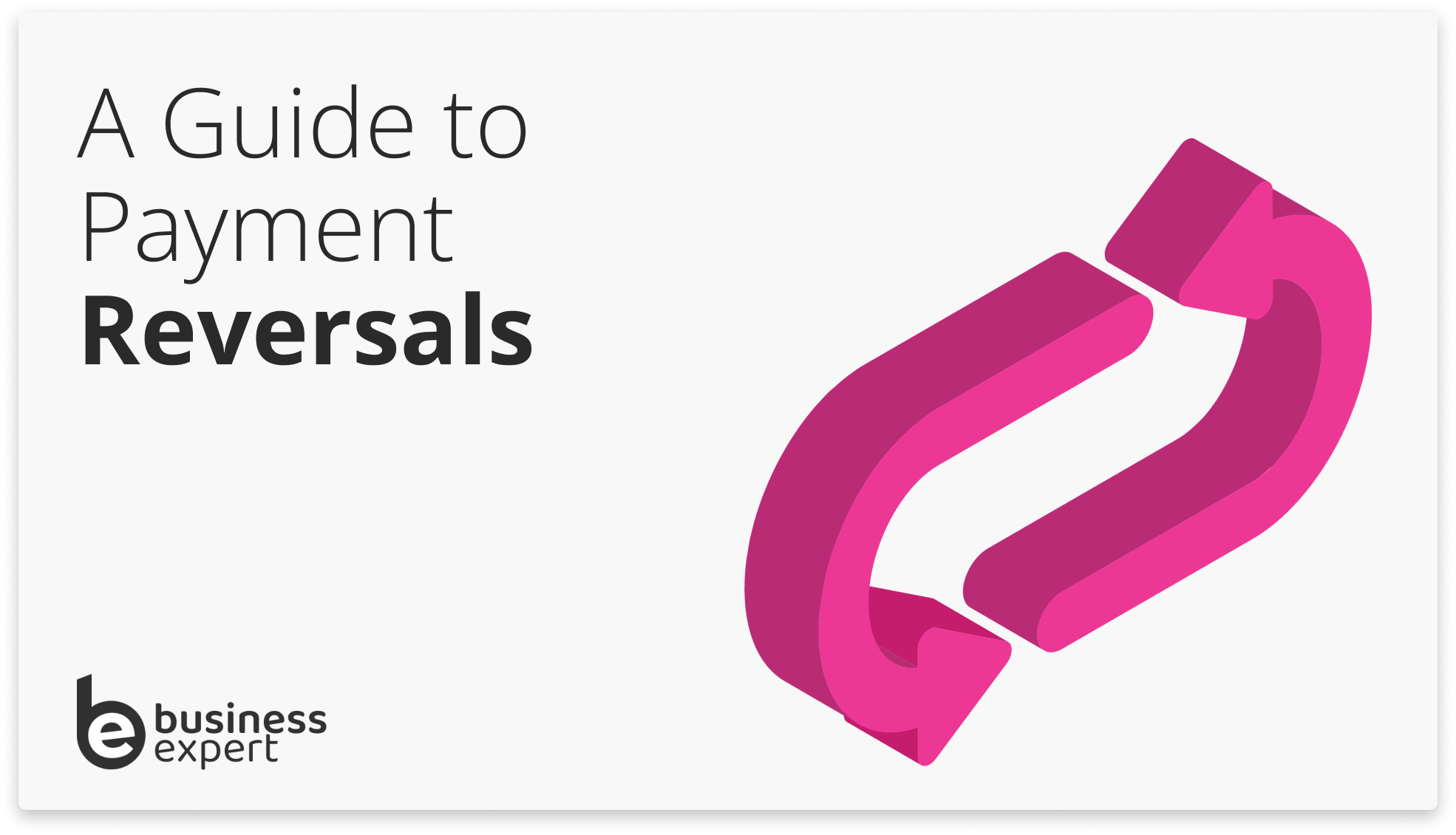Payment reversals can be time-consuming and expensive for merchants, but there are a number of ways to avoid them.
In this article, we’ll explore this area of payment processing in detail, giving you strategies for minimising their disruption to your business.


What is a payment reversal?
A payment reversal is the cancellation of a previously authorised financial transaction.
The process involves retracting the funds initially transferred, essentially taking back money already sent. It often requires scrutiny of the original payment’s circumstances and follows policies set by the business, financial institutions and regulators.
For example, a customer buys a product online and pays for it using their credit card. After the purchase, they realise there was a mistake or change their mind and ask for a refund.
In this case, the business might initiate a payment reversal. The money is returned to the customer’s credit card, undoing the transaction as if it never happened.

Types of Payment Reversal
There are multiple types of payment reversal, each used in different circumstances.
Administrative Reversal
An administrative reversal allows businesses or financial institutions to correct a financial transaction due to an administrative error.
Some of the reasons why payments are reversed include administrative errors, such as
- Incorrect amount entry,
- Wrong account crediting,
- Processing delays which lead to discrepancies in timing or execution,
- System glitches
- Internal control procedures that identify irregularities,
- Data entry errors.
The administrative reversal aims to rectify these administrative mistakes and ensure the financial records accurately reflect the intended transaction.
Authorisation Reversal
An authorisation reversal occurs when a previously approved financial transaction is cancelled or undone before it is fully completed, and the money hasn’t been transferred.
Common reasons why a payment is reversed include:
- Changes in the approved amount
- Discrepancies in payment details
- Halting transactions because of product availability, etc.
- Cancellation of services or orders before it is finalised.
Bank Reversal
A bank reversal happens when a financial institution cancels or undoes a transaction due to issues on the account holder’s side.
Some of the reasons why a bank or financial provider may reverse a payment include
- Insufficient funds,
- Closed accounts,
- Incorrect information
- Bank error,
- Exceeding transaction limits,
- Regulatory compliance.
Chargeback
A chargeback allows customers to dispute transactions and ask their bank or credit card company to reverse the payment.
The bank then investigates the dispute, and if it finds the customer’s claim valid, it reverses the payment and returns the funds to the customer.
Some of the common reasons why a chargeback may occur include:
- Non-delivery of goods or services
- Defective or substandard products
- Double charging
- Cancellation disputes arising from cancelled subscriptions or services
- Billing errors
- Violation of cardholder agreement, such as charging fees without proper disclosure
- Disputes over refunds
Fraud-Related Reversal
A fraud-related reversal is a correction initiated in response to suspected fraudulent activity to protect the business and customer from financial harm.
It involves undoing the transaction to prevent the transfer of funds to unauthorised parties and to maintain the security and integrity of financial transactions.
Common reasons why a fraud-related reversal may occur include:
- Unauthorised transactions
- Stolen payment credentials
- Identity theft
- Account hacking
- Malware or cyber attacks
- Counterfeit cards
Refunds
A refund is a return of money to a customer from a business in response to a request or agreement to maintain customer trust and satisfaction.
Some of the reasons why a refund may be issued include:
- Unsatisfactory services or products
- Return policy compliance
- Product recall
- Policy guarantee.
How Long Do Payment Reversals Take?
How long a payment reversal takes can vary depending on the circumstances.
Authorisation referrals and refunds are usually the fastest type of reversal. For debit cards, money could be returned to the customer within 1 to 5 working days, but it could take up to 30 days for credit cards.
Chargeback reversals usually take longer to complete, taking up to 90 days due to more in-depth verification procedures by the financial institution.
The process is generally designed to be relatively prompt, but the timeline may be influenced by factors such as
- Processes and policies of the business and financial institution
- Communication
- The complexity of the reversal, including the type of transaction
- Internal verification by the company and financial institution
- Regulatory requirements
- Technology and automation used
- Cooperation and communication between customers, businesses and financial institutions
- Arbitration (if necessary)
You should check with the relevant company or financial institution directly to receive up-to-date information about their policies, procedures, and expected timeframes.
How Can Businesses Prevent Payment Reversals?
While preventing every payment reversal is challenging, businesses can take several measures to minimise their risk and frequency of occurrence.
Strategies to prevent payment reversals include
- Using Secure Payment Methods: Implementing trusted payment gateways and following data security standards helps to prevent fraud, a common cause of payment reversals.
- Having a Strong Authentication Process: Two-factor authentication (2FA) helps verify customer information accurately and reduce fraudulent transactions.
- Monitoring for Suspicious Activity: Actively watching for unusual transactions can prevent unauthorised actions and minimise chargebacks.
- Accurate Billing and Record-Keeping: Ensuring billing accuracy and maintaining detailed transaction records are essential in quickly resolving disputes, a significant factor in reversing payments.
It’s important to adapt these strategies to your business’s specific needs and characteristics.
Refund vs Reversal Transaction
Many business owners confuse refunds with reversal payments and wrongly consider them the same.
Although a refund and a reversal are both processes that involve returning money to a customer, they are initiated under different circumstances and follow distinct procedures.
The table below highlights the fundamental difference between a refund and a reversal transaction:
| Aspect | Refund | Reversal Transaction |
| Trigger | A customer’s request | External factors, such as administrative errors or fraud |
| Reasons | Product defects, non-delivery of goods, or customer dissatisfaction. | Administrative mistakes, fraudulent transactions, unauthorised activities, etc. |
| Initiator | The customer begins the process | The business or financial institution |
| Customer Involvement | Customer begins the process | Customers may be informed |
| Processing Time | Varies based on the business’s policies, internal procedures, and payment method. | Varies based on the reason for the reversal, the parties involved, and specific policies. |
FAQs
If a payment is reversed, businesses should quickly review the details, talk to the customer, and document the communication. After investigating the circumstances and finding a resolution, the business owner should update their systems to prevent the same issue from happening again.
Yes, businesses can dispute a payment reversal decision if they feel it is unjust or incorrect. To do this, they should follow their payment provider’s dispute process, providing evidence to support their case.
A third-party payment processor can reduce payment reversals for businesses by offering advanced fraud detection and secure transaction processing. Many also provide dispute resolution services.
International transactions can increase the possibility of payment reversals due to more complex circumstances, such as differences in banking systems and regulations. You may also be perceived as a higher risk due to the potential for cross-border fraud.
Businesses can secure insurance to offset payment reversal financial impacts. Traditional business insurance policies might not explicitly cover losses from reversals, chargebacks, or related issues. Instead, consider specialised products like chargeback, e-commerce, cyber liability insurance, or enhance existing coverage.



